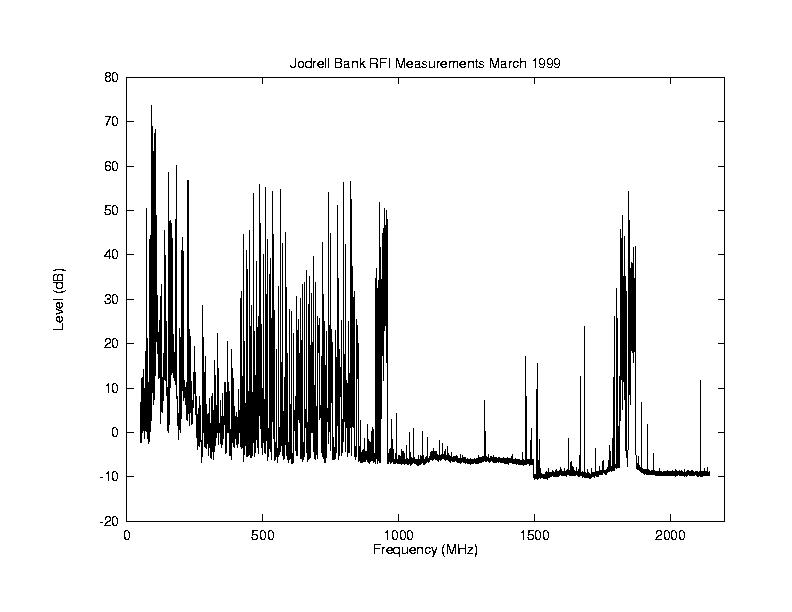Radio Frequency Interference
 Figure 1: Spectral scan of the radio environment at Jodrell Bank Observatory, measured from one of the towers of the Lovell Telescope. The frequency range is from 0 to 2 GHz. The y-axis shows power on a logarithmic scale in decibels (10dB corresponds to a factor of 10, so optical astronomers can manage decibels by noting that 4dB equals one magnitude).
Figure 1: Spectral scan of the radio environment at Jodrell Bank Observatory, measured from one of the towers of the Lovell Telescope. The frequency range is from 0 to 2 GHz. The y-axis shows power on a logarithmic scale in decibels (10dB corresponds to a factor of 10, so optical astronomers can manage decibels by noting that 4dB equals one magnitude).
In order to ensure that new instruments such as the Square Kilometre Array achieve their design sensitivity we need to find ways to minimize the impact of growing levels of man-made radio interference.
The problem of interference needs to be tackled at many levels. First we need to ensure that radio astronomy has the best possible status within the global framework of the International Telecommunications Union and the Radio Regulations. The channels for this are Working Party 7D of the Radiocommunications Bureau of the ITU, and IUCAF (IUCAF website). At a European level the channel is CRAF ( CRAF website), the European Science Foundation's Committee on Radio Astronomy Frequencies. Jodrell Bank strongly supports the work of WP7D, IUCAF and CRAF.
Jodrell Bank Observatory successfully operates in an adverse electromagnetic environment. A snapshot of the electromagnetic environment surrounding the 76-m Lovell Telescope, from 0 to 2 GHz, is shown in Figure 1. The levels of interference are billions of times stronger than the radio astronomy signals we study. Our receivers need to be built to withstand powerful levels of interference, and our signal processing techniques and data analysis techniques need to be able to discriminate against interference. Techniques for interference mitigation and for robust receiver development are coordinated internationally.
Interferometers such as MERLIN (the Multi Element Radio Linked Interferometer Network) or the VSA (Very Small Array) rely on rapid sampling, digital delays and cross-correlation techniques to achieve coherent detection of the desired signal. Interference will rarely match the astronomical source in these respects, and so interferometers are inevitably more robust against interference than single telscopes. Future interferometers are likely to go even further in terms of active rejection of interference, for example by deliberately steering null lobes towards known sources of interference.
The CRAF website has extensive information on radio astronomy interference issues in Europe. The SKA website at ATNF is the global site for sharing ideas on interference mitigation techniques.


